Content of the article
- /01 Reasons for blocking Google Merchant Center
- /02 Additional reasons for blocking Google Merchant Center
- Site map
- Cash on the site
- No SSL certificate
- Lack of an optimized mobile version of the site or errors in it
- Poor website loading speed
- Lots of banners and pop-ups
- The presence of a large number of spelling mistakes
- The site is less than 6 months old
- Verification of the website and branded elements in Google Merchant Center
- Absence of Robots.txt with a link to Sitemap.xml
- The presence of empty categories or «out of stock» products
- Mismatch of the contact number in the Merchant Center and on the website
- Lack of a review page and the ability to leave a new review
- Many pages not indexed by Google
- Publishing contacts that were previously in blocked advertising accounts
- /03 Conclusions


Merchant Center is a key tool for running merchant ads on Google that helps integrate products with the Google Merchant Center platform and provide transparency into shopping information. However, even experienced marketers and AdWords Merchant specialists may encounter Merchant Center blocking. In this article, we will look at the main and additional reasons for blocking and how to avoid such mistakes.
Reasons for blocking Google Merchant Center
The search engine strictly monitors the quality of data and transparency of information in the Merchant Center. Any inconsistencies – from errors in product descriptions to incorrect contact information – can be perceived as an attempt to mislead, which negatively affects user trust and the performance of AdWords Merchant campaigns.
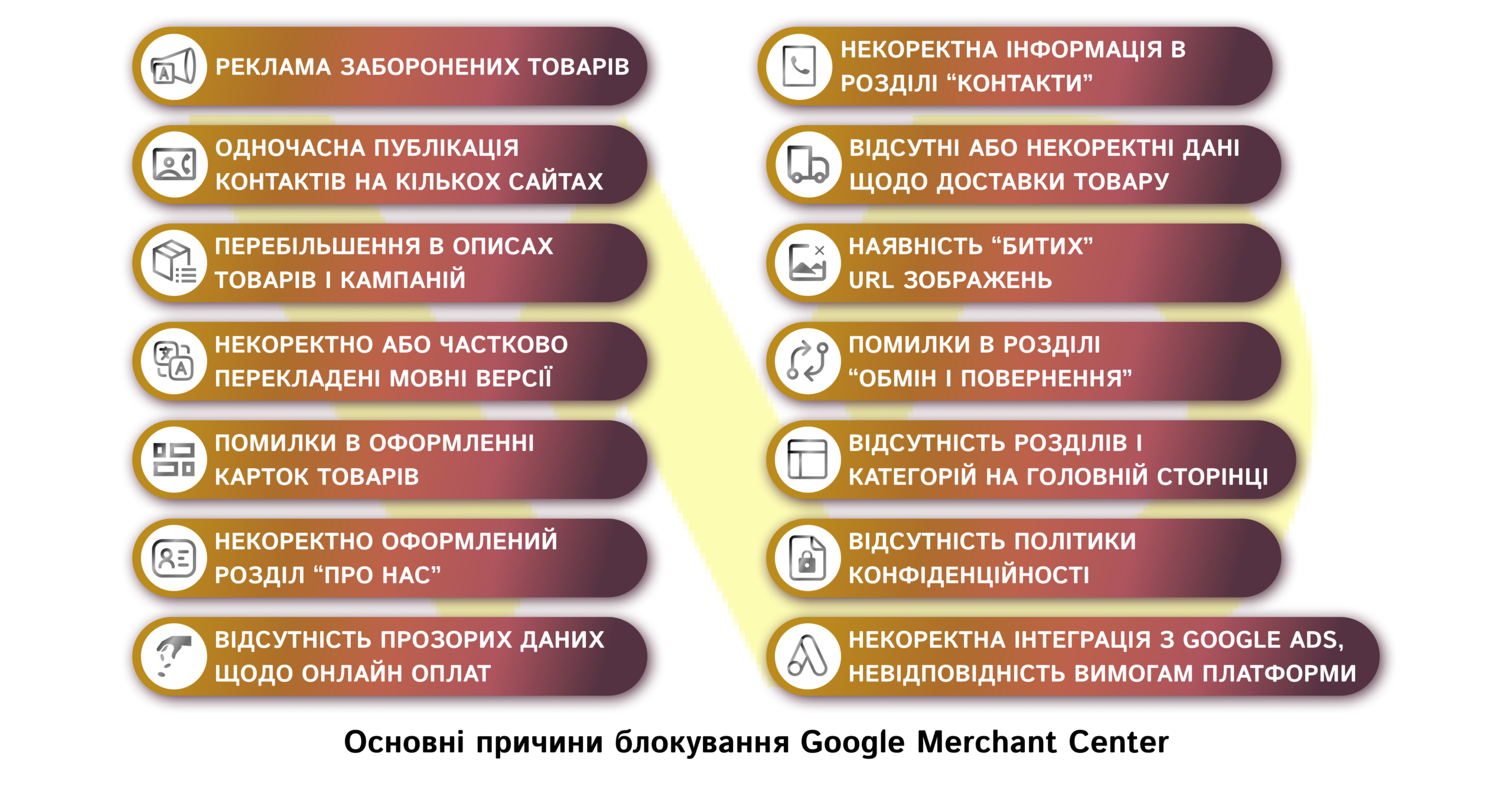
Below, we will take a closer look at the key causes of blocking so that you can identify and fix problems in the system in a timely manner.
- Advertising of prohibited goods.
The search engine regulates the content of the Merchant Centers. If your advertisement contains products that are prohibited by the platform’s policy (for example, counterfeit goods, hazardous chemicals, or misleading products), the system will automatically block your account. For example, if a store offers a fake branded watch, it can be perceived as misleading. The full list of prohibited products for advertising can be found in the official Help.
- Simultaneous publication of contact information on several websites.
The presence of the same contact information on different resources raises questions about credibility and may be considered an attempt to deceive.
For example, imagine TechWorld, a company specializing in the sale of electronic gadgets. The company has launched its main website techworld.ua, as well as two additional resources: a blog techworldnews.ua and a partner website techworldpartners.ua. All of these platforms have the same phone number and email address in their contacts. This situation may raise suspicions, as the repetition of contact information on several resources looks like an attempt to hide the true nature of the business or mislead users.
- Exaggeration in product and campaign descriptions.
Exaggerations in descriptions can create false expectations among users, leading to a loss of trust in both the brand and the data on the platform. Exaggerated promises and unsubstantiated claims are considered misleading, which negatively affects the transparency of information in the system.
For example, consider an imaginary company called TechSolution, which promotes its latest gadget with the following statement: «Our product is guaranteed to improve the quality of your life by 200%, solving all household problems – from cleaning to cooking!» Such unrealistic promises, not supported by objective information or reviews, are perceived by search engine algorithms as an attempt to mislead. Such exaggerations can raise questions about the authenticity of the content provided, which ultimately leads to account blocking.
Such an approach to ads reduces the value of information and violates the principle of transparency, which is critical for effective advertising and successful work on the platform. If you are facing similar problems, WEDEX marketing agency specialists can help you optimize your descriptions and bring your data in line with Google’s requirements, ensuring the stability and effectiveness of your advertising campaigns.
- Incorrect language versions.
Incorrectly or partially translated language versions of a website may create the impression of dishonesty. If a website contains different language versions with errors, Google Merchant Services may block the account.
- Errors in the design of product cards.
The correct design of product cards is crucial for building user trust in your online store and ensuring the successful operation of the system.
If the price of a product is incorrect due to outdated information or currency conversion errors, users may perceive a discrepancy between the price on the card and the actual price on the website as an attempt to mislead. Even small inaccuracies in the data can negatively affect brand perception, which reduces the credibility of Merchant Shopping.
Incomplete or false product descriptions are also a serious problem. You should not allow product characteristics to be listed with errors or not true. Google closely monitors the accuracy of information, and inconsistencies are perceived as a violation of the principles of transparency. It is also important that product images accurately reflect their characteristics. A discrepancy between the image and the actual appearance of the product can be perceived as a fraud, which worsens the reputation of the store and may lead to refusal to publish in the Merchant Center.
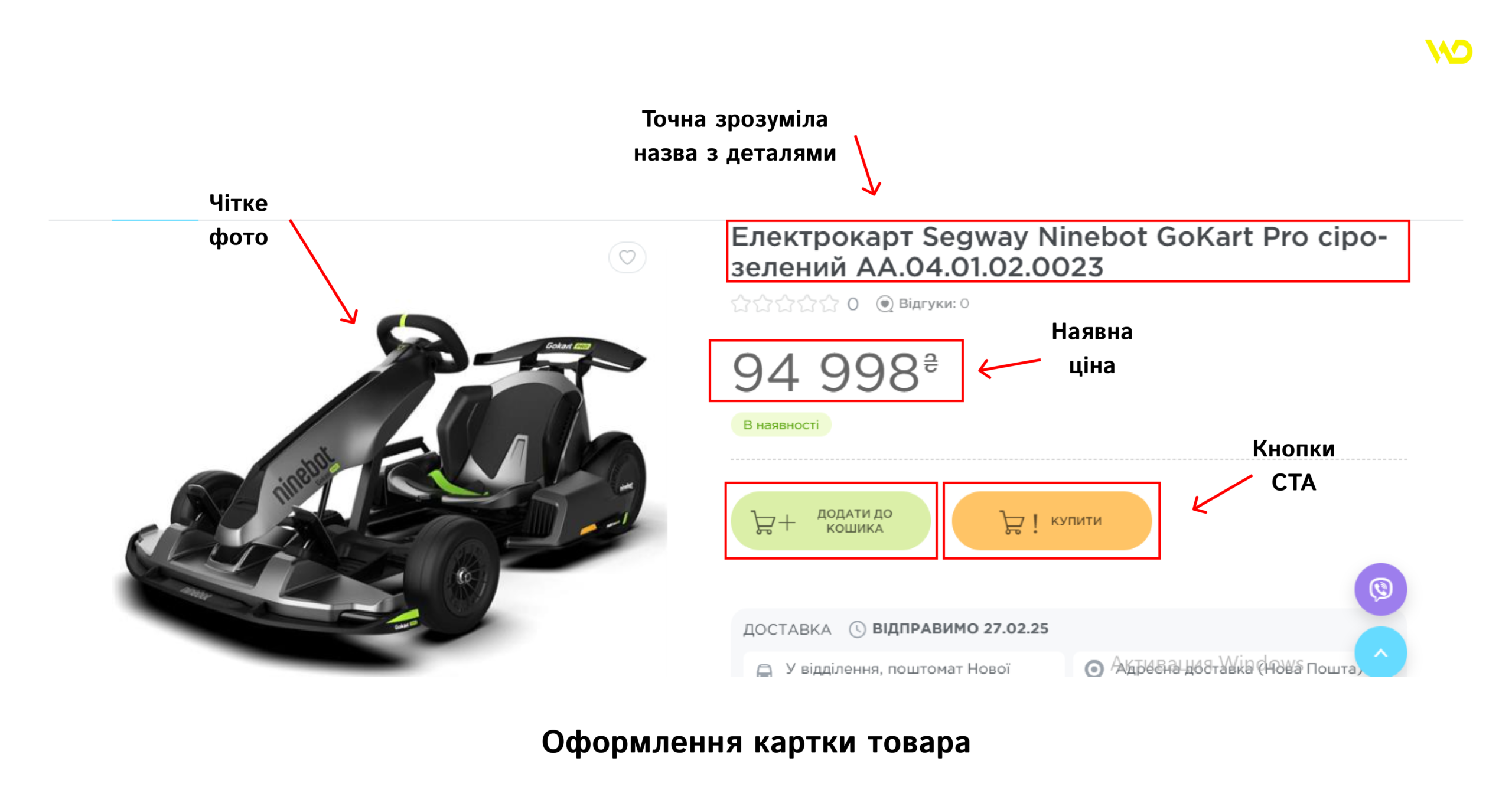
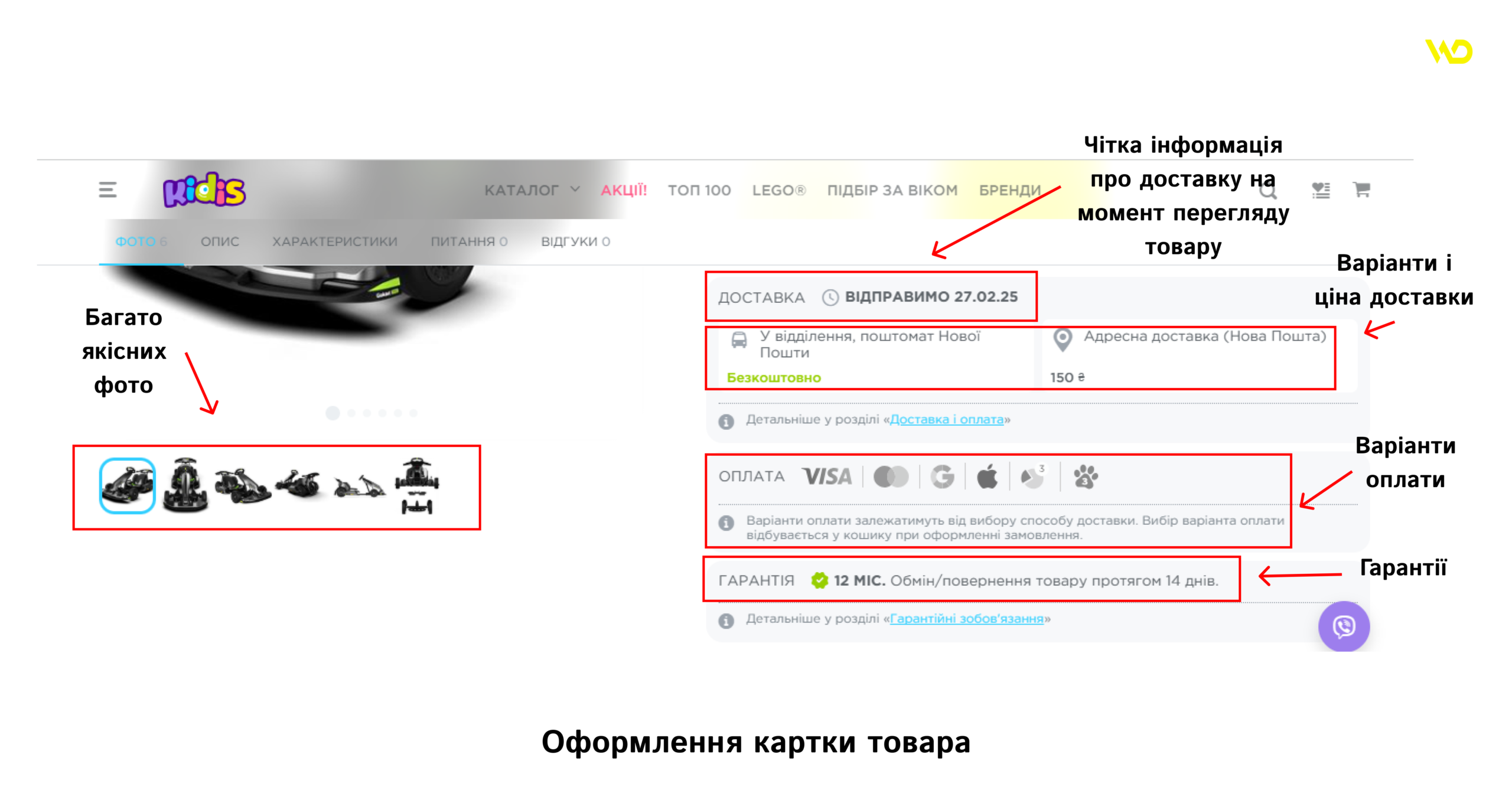
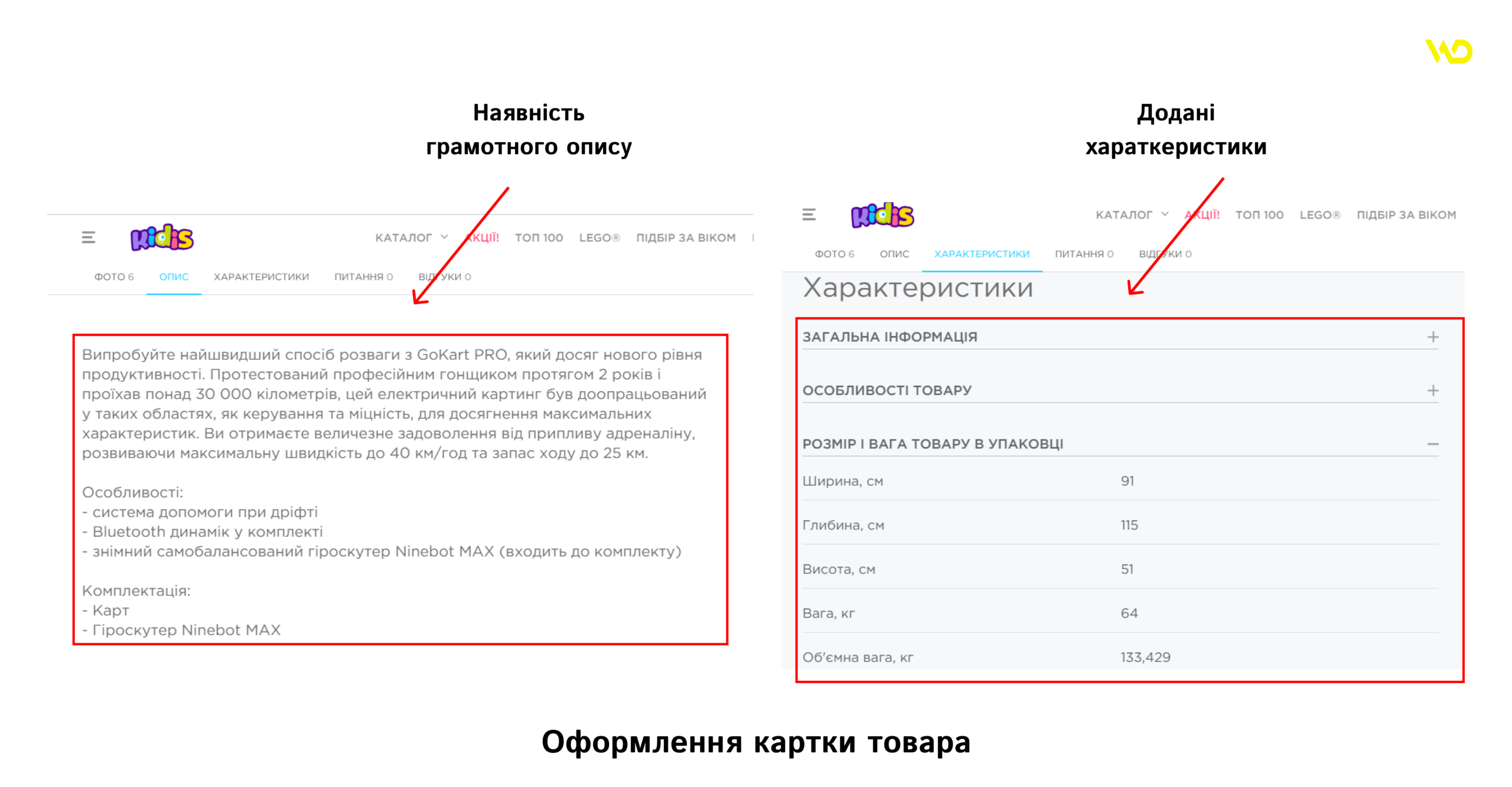
Please note! The described mistakes in the design of product cards can lead not only to account blocking, but also to the loss of potential customers. To avoid such situations, it is recommended to regularly check product cards, update all information in them, and use automated control tools.
- The «About Us» section is incorrectly designed.
The «About Us» section on a website is important in demonstrating the authenticity of the brand. Lack of detailed information or obvious inconsistencies can signal fraud and arouse suspicion from the search engine.
For example, let’s imagine FreshBasket, a company that sells organic products. Their «About Us» section states: «We offer the best organic products». As you can see, there is no information about who is behind the company, when it was founded, where the farms are located, and there is no mention of certification or partners. Moreover, some products state that they are grown on eco-farms, but the website does not have images of farms or other evidence to support this fact.
The absence of text or a vague representation of the brand creates the impression that the company lacks credibility, which can be seen as an attempt to provide incomplete or false information. This severely undermines the transparency and authenticity of the brand, calling into question its integrity. As a result, Google can block an account on the platform for the absence of important information that indicates an attempt to mislead.
- Lack of transparent data on online payments.
To gain user trust, you need to provide complete information about payment methods and transaction security. If this information is missing or incomplete, it reduces the transparency of advertising and may lead to a refusal to publish AdWords Merchant campaigns. The search engine requires that the website of an online store clearly indicates the available payment methods. Shops that do not provide information about commissions, payment terms, or transaction security are more likely to face blocking in Google Merchant Center.
To avoid problems, it is important to update information about payment systems in a timely manner and ensure transparency of all processes.
- Incorrect information in the Contacts section.
Incorrect or outdated contacts, lack of a physical address or phone number make a website suspicious. For example, if the phone number is incorrect or there is no way to contact it, it can be perceived as an attempt to mislead.
- Missing or incorrect data on the delivery of goods.
Users should receive clear information about the terms, cost, and conditions of delivery. Incomplete or contradictory information negatively affects the perception of the store, which can lead to a Google Merchant Center ban.
For example, Svit Smaku states on its homepage that delivery is carried out within 3-5 days, while in the section «Delivery and Payment» it states that the time depends on the region and can reach 7 days, and the delivery cost is ambiguous. This inconsistent and contradictory presentation of information misleads users.
- The presence of broken URLs of images.
The quality of images is one of the key factors in evaluating a Merchant Center. If links to images do not work (there are broken URLs) or the images themselves are of poor quality, this can negatively affect the trust of both users and search engine algorithms. Failure to meet the requirements for uploading and displaying images can lead to data rejection.
Aspects to consider:
- URL verification: regularly audit all image URLs using specialized tools (e.g., Screaming Frog, Xenu, or Google Search Console). This will allow you to identify broken links that return errors (404, 500, etc.) and fix them quickly;
- optimize the quality of images: they should be clear, high resolution, comply with recommended formats (JPEG, PNG, WebP) and have an optimal size. Poor quality or blurry photos can be perceived as a sign of negligence, which reduces the level of trust;
- loading speed: important for providing a comfortable user experience. If images load slowly due to unoptimized files or incorrect URLs, this can negatively affect the site’s search engine rankings;
- Google compliance: the quality and availability of images is an important part of data verification. Broken links or images that do not meet the requirements may be considered as an attempt to deceive users, which leads to account blocking.
Keep in mind that keeping images up-to-date and of high quality is not only a matter of technical optimization, but also an element of increasing your brand’s credibility.
- Errors in the Exchange and Returns section.
Incomplete or incorrect information about the exchange and return policy also reduces user confidence. If the procedure for returning goods is not specified or raises questions, the system may consider such information insufficiently transparent.
- Lack of sections and categories on the main page of the website.
Website structure affects the ease of navigation and data indexing. The absence of a clear structure, sections, and categories creates the impression of disorder, which negatively affects the Google Shopping Merchant Center ranking.
- Lack of privacy policy.
Users and search engines demand transparency in the collection and processing of personal data. Having a detailed privacy policy is a mandatory requirement for a Merchant Center.
The absence of this information can lead to blocking. To avoid this, the website should clearly state information about the collection, storage and processing of personal data. The policy should contain a description of what data is collected, for what purposes it is used, as well as information on the use of cookies and mechanisms for protecting the collected information.
- Incorrect integration with Google Ads or non-compliance with the platform requirements.
This can automatically lead to the blocking of your account in Google Merchant Center. If advertising campaigns do not comply with AdWords standards, it affects all the information provided and reduces the transparency of advertising.

The search engine pays attention to the consistency of the information provided in the Merchant Center and the data used in Google Ads advertising campaigns. A discrepancy, for example, between the current prices or product descriptions on the website and the information presented in the ads may be perceived as an attempt to mislead. Even minor discrepancies can be a reason for blocking, as the system strives to maintain a high degree of transparency and reliability of information.
In addition, technical errors in setting up Google Ads integration, such as incorrectly linking accounts or using outdated data, can also negatively affect your account’s reputation. Violations of AdWords standards lead to a decrease in the credibility of your account on the platform.
To avoid such problems, you need to regularly audit the integration of Google Ads with Merchant Center, verify all information, and update your advertising campaigns in accordance with the search engine’s current requirements.
Want to prevent Merchant Center from being blocked?
We will audit your advertising campaigns, identify risks, and help you avoid possible blocking. Leave a request - we will ensure the smooth operation of your advertising!
Additional reasons for blocking Google Merchant Center
There are additional factors that can negatively affect your account performance. They are related to the technical and structural aspects of the site that affect the quality of data and transparency of advertising. This can lead to the fact that Google Merchant Center algorithms perceive the site as unreliable.

Let’s take a closer look at additional reasons to help you avoid blockages and ensure stable operation.
Site map
The absence or incorrect design of the XML sitemap makes it difficult to index data, which negatively affects the operation of the Google Shopping Merchant Center. For example, an outdated sitemap leads to the fact that new products are not displayed in the search.
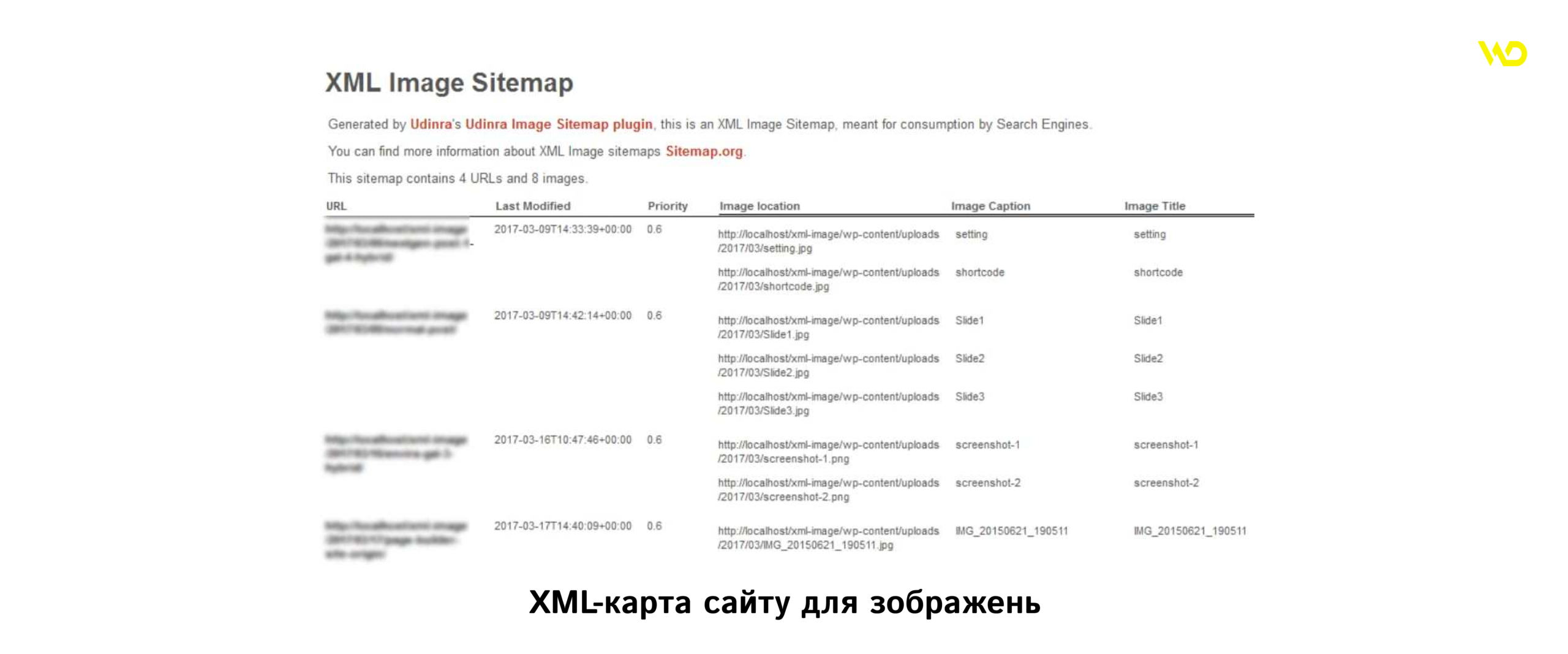
Cash on the site
Excessive or incorrect cache can prevent information from being updated. This leads to the fact that the data from the merchandise will be out of date, and the system will not be able to process the information correctly.
No SSL certificate
An SSL certificate is a mandatory requirement for user security. The absence of a secure connection is perceived as a risk and can lead to blocking of the Merchant Center.
Lack of an optimized mobile version of the site or errors in it
Considering that most users make purchases via mobile devices, errors in the mobile version negatively affect the user experience and, consequently, the ranking of Google Shopping Merchant Center.
Poor website loading speed
Slow loading of pages, especially the mobile version of the site, reduces the user experience and can negatively affect the indexing of the site in Google. This is important for maintaining the Google Merchant status and displaying content correctly.
Lots of banners and pop-ups
An excessive number of pop-ups or intrusive ads disturb users, which can be seen as an attempt to mislead. This negatively affects the perception of advertising transparency.
The presence of a large number of spelling mistakes
Errors on the home page, product cards, or categories indicate that you are not paying attention to the quality of your content. This reduces the value of the content and the trust of both users and search engine algorithms.

The site is less than 6 months old
Resources with a short age often arouse suspicion because they have not yet built a reputation. In such cases, additional confirmation of the reliability of the information is required to avoid blocking.
Verification of the website and branded elements in Google Merchant Center
It is important that the site is confirmed via SMS and that brand colors and logo are added correctly. Failure to comply with this requirement may result in the rejection of the account by Google Shopping Merchant Center.
Absence of Robots.txt with a link to Sitemap.xml
Robots.txt helps to manage website indexing. If it is missing or does not contain a link to Sitemap.xml, it complicates the work of search robots and reduces data transparency.
The presence of empty categories or «out of stock» products
Empty categories and pages with no information about products create a feeling of incompleteness. This reduces trust and can be perceived as an attempt to hide real data.
Mismatch of the contact number in the Merchant Center and on the website
If the phone number listed in the Merchant Center does not match the information on the website, this raises questions about the reliability of the information. Such a discrepancy can lead to a blocking, as the data on the merchandise is missing.
Lack of a review page and the ability to leave a new review
Testimonials are an important element of trust. If a website doesn’t provide an opportunity for feedback, it can be perceived as an attempt to mislead.
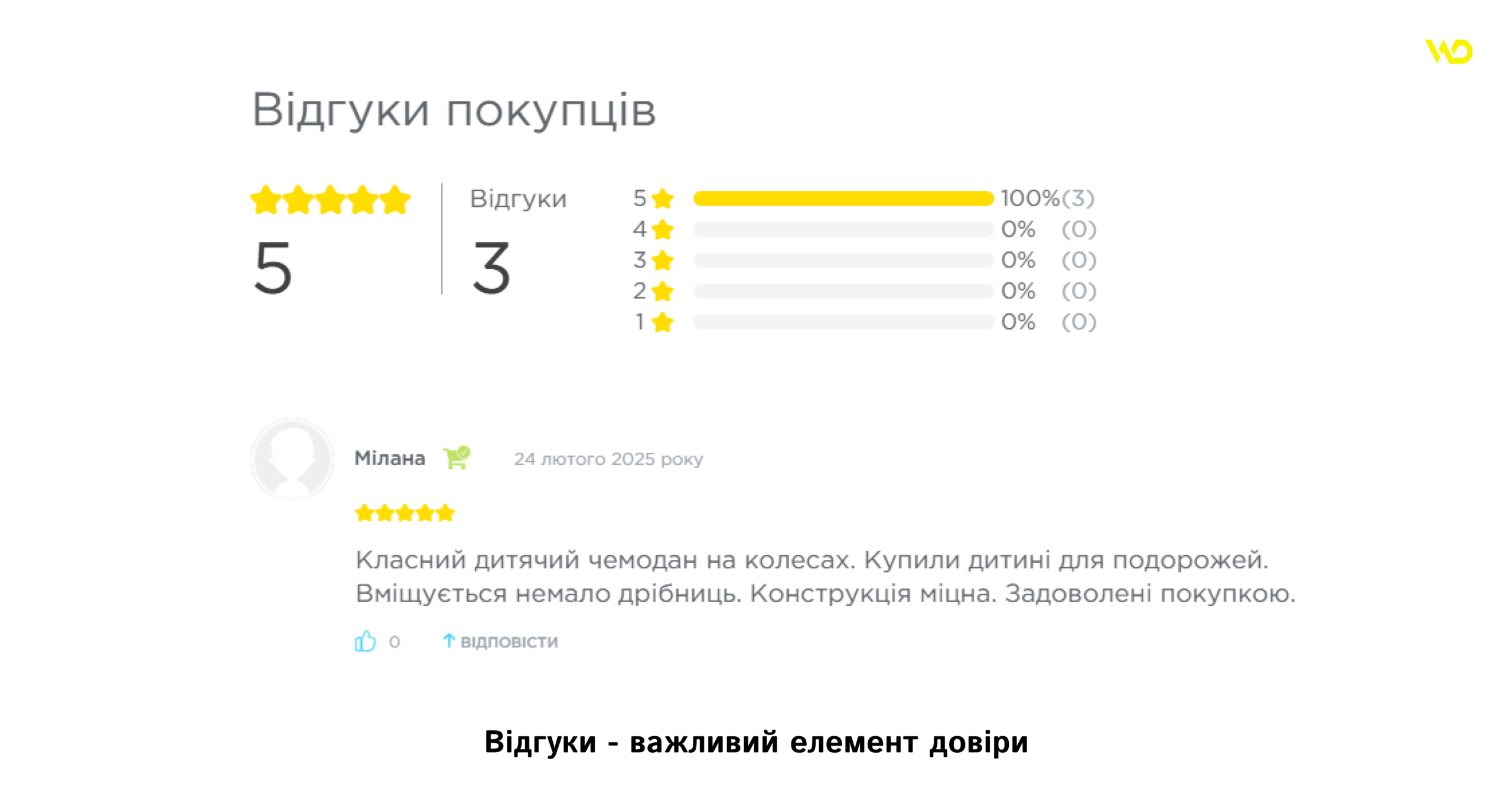
Many pages not indexed by Google
It is optimal if more than 80% of the site’s pages are available for indexing. If a significant part of the pages is not indexed, it negatively affects the reputation of Google Merchant Center.
Publishing contacts that were previously in blocked advertising accounts
Reusing information from previously blocked accounts is an alarming signal for the system. It can be seen as an attempt to circumvent the rules, which increases suspicions of misleading.
Conclusions
Blocking a Merchant Center in Google is not only a technical problem, but also a reputational one. Each of the reasons considered, whether it is data errors or insufficient transparency of information, affects the possibility of successful promotion of a Google Ads and AdWords Merchant campaign. To achieve maximum efficiency, it is important to pay attention to every element of the website. By following the recommendations described in this article and avoiding mistakes, you will be able to ensure the stable operation of Google Shopping Merchant Center and successful advertising campaigns.
If you are unable or do not have time to solve problems with Google Merchant Center, WEDEX marketing agency specialists are ready to offer professional assistance in unlocking and optimizing your account, ensuring the correctness of information and high quality of merchant advertising.






 05/03/2025
05/03/2025  2849
2849


